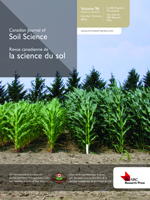Miller, J. J., Beasley, B. W., Drury, C. F. and Zebarth, B. J. 2011. Accumulation and redistribution of residual chloride, nitrate, and soil test phosphorus in soil profiles amended with fresh and composted cattle manure containing straw or wood-chip bedding. Can. J. Soil Sci. 91: 969-984. Limited research has compared the effect of fresh versus composted beef (Bos taurus) cattle feedlot manure containing straw or wood chips on accumulation and redistribution of residual chloride (Cl), NO3-N, and soil test P (STP) in soil profiles of the Great Plains region of North America. Barley (Hordeum vulgare L.) was grown (1999-2007) on an irrigated clay loam soil in southern Alberta where organic amendments and fertilizer were annually applied for 9 yr from 1998 to 2006. The field experiment was a factorial arrangement of two manure types (fresh versus composted feedlot manure), two bedding materials (straw versus wood-chips), and three application rates (13, 39, 77 Mg ha-1 dry wt). There was also one inorganic (IN) fertilizer treatment and an unamended control. The soil profile (0-1.5 m) was sampled in the fall of 1999 to 2002, 2004, 2006, and 2007 and analyzed for residual soil NO3-N, Cl, and STP. Manure type had a significant (P≤0.05) effect on the accumulation of these chemicals, but there was an interaction with application rate (NO3-N), or with bedding and year (STP). The maximum accumulation of Cl after 9 yr was at the 0.6 to 0.9 m depth, but mean values at this depth were similar for the four organic amendments. The maximum accumulation of NO3-N after 9 yr (2007) was at the 0.3 to 0.6 m depth, and mean values at this depth were significantly greater by four- to sixfold for FM and CM with straw than wood-chips, which suggested greater N immobilization in soils with wood. Redistribution of Cl and NO3-N downward into the soil profile suggested a potential for leaching of these chemicals below the root zone. In contrast, soil test P did not accumulate below the 0.3 m depth, suggesting little potential for leaching. However, accumulation of soil test P at this depth was generally greater for the amendment treatments compared with inorganic fertilizer and was likely related to greater P applied in the amendments.
BioOne.org will be down briefly for maintenance on 13 August 2025 between 18:00-21:00 Pacific Time US. We apologize for any inconvenience.
How to translate text using browser tools
1 November 2011
Accumulation and redistribution of residual chloride, nitrate, and soil test phosphorus in soil profiles amended with fresh and composted cattle manure containing straw or wood-chip bedding
J. J. Miller,
B. W. Beasley,
C. F. Drury,
B. J. Zebarth
ACCESS THE FULL ARTICLE
It is not available for individual sale.
This article is only available to subscribers.
It is not available for individual sale.
It is not available for individual sale.
accumulation
accumulation
Chloride
chlorure
composted manure
fresh manure
fumier composté





